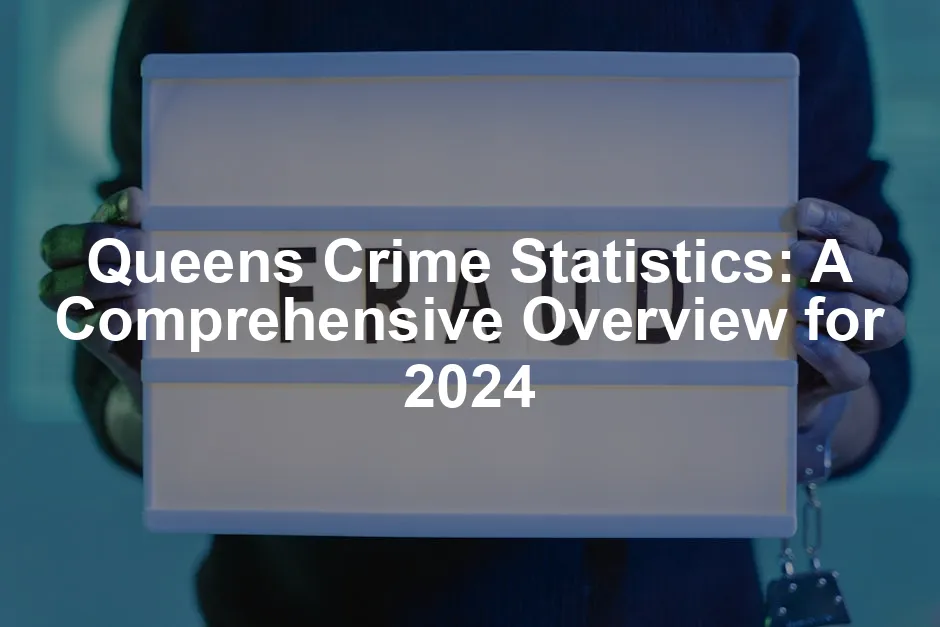Introduction
Welcome to our deep dive into the world of Queens crime statistics! If you think crime stats are as exciting as watching paint dry, think again. Understanding these numbers is essential for residents, potential visitors, and policymakers. Why? Because knowledge is power, and being informed helps you navigate your surroundings smartly.
Crime trends in Queens, NY, can paint a vivid picture of safety (or lack thereof) in this diverse borough. For example, if you’re eyeing a visit to Astoria for its fantastic Greek food, knowing the local crime rates can help you decide on the best time to stroll down the streets. On the flip side, policymakers can use this data to allocate resources effectively and create safer neighborhoods.
This article draws on data from reputable sources, including the NYPD and NeighborhoodScout, covering crime statistics up to October 2023. So grab your magnifying glass and let’s uncover the nitty-gritty of Queens’ crime landscape!
Overview of Queens Crime Statistics
Queens is bustling with life, but it’s essential to know the safety situation. The total crime rate in Queens stands at 22 crimes per 1,000 residents. Compare that to the New York State average, and you’ll find that Queens is slightly above the state average. However, when you look at national averages, Queens is safer than many similarly sized cities across the U.S.
This leads us to an interesting perception: While crime exists, many residents feel relatively safe. Recent surveys indicate that 87% of locals report feeling “pretty safe,” despite the numbers. It’s like knowing your favorite sandwich shop is in a busy area but still enjoying your lunch without a care in the world.
When breaking it down by neighborhoods, the crime rate can vary significantly. For example, areas like Bayside and Belle Harbor are often considered safer, while parts of Jamaica and South Ozone Park experience higher crime rates. This divergence highlights the importance of understanding local dynamics.
While Queens has its challenges, it remains a vibrant community. With each neighborhood contributing to the overall safety perception, it’s crucial to stay informed. After all, knowledge is the best defense!

Detailed Breakdown of Crime Types
Violent Crimes in Queens
Violent crimes are serious offenses that involve force or threat against individuals. Such crimes include armed robbery, aggravated assault, rape, and murder. In Queens, the violent crime rate sits at about 5 per 1,000 residents. This rate presents a nuanced picture of safety in the borough.
The most prominent violent crimes reported include:
- Armed Robbery: This crime often leaves victims feeling vulnerable in their neighborhoods.
- Aggravated Assault: A significant concern, especially in specific precincts.
- Rape: Alarmingly, recent statistics reveal a spike in reported rapes, particularly in northern Queens.
- Murder: Thankfully, murder rates remain relatively low but are still a cause for concern.
Looking at the victimization rates, the chance of becoming a victim of a violent crime in Queens is approximately 1 in 211. Over the past few years, trends have shown a mixed bag of increases and decreases across various categories. For instance, the NYPD reported a stark 121.4% increase in rapes year-over-year from June 2023 to June 2024, climbing from 14 cases to 31.
Particularly in northern Queens, areas such as Astoria and Long Island City have seen significant increases in felony assaults. The 115th Precinct reported a dramatic rise, where felony assaults surged from 32 to 69 in just one year. This uptick raises eyebrows and calls for community vigilance.
Yet, it’s not all doom and gloom. Certain neighborhoods within Queens, like Bayside, remain relatively safe havens. Understanding these trends helps residents stay informed and proactive.

Property Crimes in Queens
Property crimes involve the theft of property or damage to possessions. In Queens, the property crime rate stands at 17 per 1,000 residents, leading to a victimization chance of about 1 in 59. Common property crimes include motor vehicle theft, arson, larceny, and burglary.
To keep your belongings safe, consider investing in a Home Security Camera System. This modern-day fortress allows you to monitor your property from anywhere, giving you peace of mind even when you’re not home.
The year-over-year trends tell an interesting story. Certain neighborhoods have seen fluctuations in crime rates, with some experiencing declines. For example, grand larcenies have dropped significantly in many precincts. The 110th Precinct, which covers Corona and Elmhurst, noted a decrease of 9.2% in grand larcenies, falling from 148 cases last year to just 108 this year.
Despite these positive shifts, property crimes still pose challenges. Motor vehicle theft remains a concern, with many residents taking extra precautions. It’s worth noting that while some areas face rising crime rates, others are benefiting from community programs aimed at enhancing safety.
Analyzing these property crime trends can empower residents. Knowing which areas have lower crime rates allows for smarter decisions about where to live or frequent. Neighborhoods like Belle Harbor and Bayside consistently rank among the safest, providing a reassuring environment for families and individuals alike.
In summary, while Queens grapples with crime, understanding the specific types of crime and their trends can help residents navigate their surroundings more effectively. With the right information, staying safe becomes a community effort.

Crime Trends Over Time
Queens has seen interesting fluctuations in crime rates over the years. As we assess the statistics for 2024, it’s crucial to compare these figures with those from previous years. The latest data from the NYPD reveals some noteworthy insights.
In 2024, the overall crime rate in Queens stands at approximately 22 crimes per 1,000 residents. This is a slight increase compared to 2023, which recorded about 21.79 crimes per 1,000 residents. Such numbers might make you raise an eyebrow, but let’s break it down further.
Violent crimes are particularly significant in this analysis. The violent crime rate sits around 5 per 1,000 residents, mirroring the pattern observed in previous years. While some categories have shown slight increases, like felony assaults in northern precincts, others, such as murder rates, have seen declines. For instance, murders decreased by 11% from 2023 to 2024, dropping from 43 to 24 reported incidents.
To be prepared for any emergencies, it’s essential to have a First Aid Kit for Home and Travel. It’s a small investment that can make a huge difference when accidents happen.
Property crimes also tell a mixed story. While larcenies have decreased in certain areas, like the 110th Precinct where grand larcenies dropped by 9.2%, other property crimes, such as burglaries, have remained relatively stable or increased slightly in specific neighborhoods.
Significant trends emerge from this data. For example, the 115th Precinct has seen a sharp rise in felony assaults, jumping from 32 to 69 incidents in just one year. This alarming spike emphasizes the need for increased community vigilance.
Overall, the crime landscape in Queens is one of contrast. On one hand, certain neighborhoods are experiencing rising crime rates, while others are benefiting from community safety initiatives. Understanding these trends is essential for residents and visitors alike, allowing them to make informed choices about their safety and well-being. As the year progresses, keeping an eye on these statistics will be crucial in navigating the vibrant yet complex environment of Queens.

High-Crime Areas in Queens
Queens, known for its vibrant diversity, does have neighborhoods facing higher crime rates. Understanding these areas is crucial for residents and visitors alike.
Some neighborhoods are notorious for their elevated crime statistics. Jamaica, South Ozone Park, and parts of Corona often top the list for crime. For example, Jamaica has seen a notable surge in violent crimes over the past year. The 115th Precinct, which includes parts of this area, reported a staggering 46.9% increase in felony assaults from last year. That’s a spike that makes you double-check your evening plans!
So, what’s driving these crime rates? A cocktail of factors plays a role, including economic disparities, limited access to education, and community resources. Areas with high poverty levels often see increased crime. Additionally, the availability of drugs and firearms can contribute to violence.
However, the community isn’t just sitting back and letting crime take over. Local organizations and residents are actively responding. Initiatives like community policing aim to bridge the gap between law enforcement and residents. Officers are more visible and approachable, fostering trust.
For personal safety, consider carrying a Personal Safety Alarm Keychain. It’s small and discreet, but it can make a big difference in an emergency situation.
Mentorship programs have also sprung up, targeting at-risk youth. These initiatives provide guidance and support, steering young people away from criminal activities. Public safety campaigns, often led by grassroots organizations, aim to educate residents on safety measures, promoting vigilance.
In summary, while certain areas in Queens grapple with higher crime rates, the community’s resilience shines through. By tackling the root causes and fostering collaboration, residents are working together to create safer neighborhoods. Understanding these dynamics can empower you to make informed choices about where to live and visit in this thriving borough.

Conclusion
In summation, Queens has a vibrant yet complex crime landscape. The overall crime rate stands at approximately 22 crimes per 1,000 residents. This statistic helps us understand the safety dynamics in this diverse borough. While crime exists, many residents report feeling relatively secure. In fact, 87% of locals express a sense of safety in their neighborhoods.
However, the crime statistics underscore the importance of staying informed. Knowledge empowers residents and visitors to make safer choices. Understanding local crime trends can influence decisions about where to live, work, and visit. For instance, if you’re planning a night out in Astoria, being aware of the latest crime reports can help you choose the best routes and times to go out.
Moreover, community involvement plays a crucial role in enhancing safety. Local safety initiatives, from neighborhood watch groups to community policing efforts, foster collaboration between residents and law enforcement. When communities come together, they create an environment that promotes vigilance and proactive measures against crime.
To ensure you’re prepared for emergencies, consider investing in a Roadside Emergency Kit. You never know when you might need it!
Encouraging residents to participate in safety initiatives is vital. Whether it’s attending community meetings or volunteering for local programs, every effort counts. Your involvement can make a difference in building a safer Queens. Stay informed, stay involved, and together, we can create a more secure environment for all.

FAQs
What is the overall crime rate in Queens?
The overall crime rate is approximately 22 crimes per 1,000 residents.
How do crime rates in Queens compare to the rest of New York City?
Queens has a higher crime rate than many parts of New York, but it is safer compared to similarly sized cities in the U.S.
What should I know about safety in Queens?
While Queens has areas with higher crime rates, many neighborhoods are considered safe, especially during the day.
Are crime rates in Queens trending up or down?
Recent statistics show mixed trends, with some crimes increasing while others are declining.
For a deeper understanding of crime trends in Texas, check out this comprehensive analysis. texas crime rate statistics
Please let us know what you think about our content by leaving a comment down below!
Thank you for reading till here 🙂
All images from Pexels




